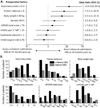The relationship between clinical phenotype and early staged bilateral deep brain stimulation in Parkinson disease
- PMID: 24074493
- PMCID: PMC3992872
- DOI: 10.3171/2013.8.JNS122025
The relationship between clinical phenotype and early staged bilateral deep brain stimulation in Parkinson disease
Abstract
Object: While many centers place bilateral deep brain stimulation (DBS) systems simultaneously, unilateral subthalamic nucleus (STN) DBS followed by a staged contralateral procedure has emerged as a treatment option for many patients. However, little is known about whether the preoperative phenotype predicts when staged placement of a DBS electrode in the opposite STN will be required. The authors aimed to determine whether preoperative clinical phenotype predicts early staged placement of a second STN DBS electrode in patients who undergo unilateral STN DBS for Parkinson disease (PD).
Methods: Eighty-two consecutive patients with advanced PD underwent unilateral STN DBS contralateral to the most affected hemibody and had at least 2 years of follow-up. Multivariate logistic regression analysis determined preoperative characteristics that predicted staged placement of a second electrode in the opposite STN. Preoperative measurements included aspects of the Unified Parkinson's Disease Rating Scale (UPDRS), motor asymmetry index, and body weight.
Results: At 2-year follow-up, 28 (34%) of the 82 patients had undergone staged placement of a contralateral electrode while the remainder chose to continue with unilateral stimulation. Statistically significant improvements in UPDRS total and Part 3 scores were retained at the end of the 2-year follow-up period in both subsets of patients. Multivariate logistic regression analysis showed that the most important predictors for early staged placement of a second subthalamic stimulator were low asymmetry index (OR 13.4, 95% CI 2.8-64.9), high tremor subscore (OR 7.2, CI 1.5-35.0), and low body weight (OR 5.5, 95% CI 1.4-22.3).
Conclusions: This single-center study provides evidence that elements of the preoperative PD phenotype predict whether patients will require early staged bilateral STN DBS. These data may aid in the management of patients with advanced PD who undergo STN DBS.
Conflict of interest statement
Financial disclosure/conflict of interest: The authors have no disclosures or conflicts of interest to report regarding the research covered in this manuscript.
Figures

Similar articles
-
Two-year follow-up on the effect of unilateral subthalamic deep brain stimulation in highly asymmetric Parkinson's disease.Mov Disord. 2009 Feb 15;24(3):329-35. doi: 10.1002/mds.22211. Mov Disord. 2009. PMID: 19006187 Clinical Trial.
-
Assessment of the effects of unilateral electrode dysfunction in patients with Parkinson disease undergoing bilateral subthalamic nucleus deep brain stimulation.Neurosurgery. 2012 Mar;70(1 Suppl Operative):163-9; discussion 169. doi: 10.1227/NEU.0b013e31822d5d4c. Neurosurgery. 2012. PMID: 21768919
-
Meta-analysis comparing deep brain stimulation of the globus pallidus and subthalamic nucleus to treat advanced Parkinson disease.J Neurosurg. 2014 Sep;121(3):709-18. doi: 10.3171/2014.4.JNS131711. Epub 2014 Jun 6. J Neurosurg. 2014. PMID: 24905564
-
Congress of Neurological Surgeons Systematic Review and Evidence-Based Guideline on Subthalamic Nucleus and Globus Pallidus Internus Deep Brain Stimulation for the Treatment of Patients With Parkinson's Disease: Executive Summary.Neurosurgery. 2018 Jun 1;82(6):753-756. doi: 10.1093/neuros/nyy037. Neurosurgery. 2018. PMID: 29538685 Free PMC article.
-
Olfactory changes in patients with Parkinson's disease undergoing deep brain stimulation in the subthalamic nucleus: a systematic review and meta-analysis.Neurosurg Rev. 2025 Mar 27;48(1):333. doi: 10.1007/s10143-025-03479-0. Neurosurg Rev. 2025. PMID: 40146437
Cited by
-
The effect of unilateral subthalamic nucleus deep brain stimulation on depression in Parkinson's disease.Brain Stimul. 2017 May-Jun;10(3):651-656. doi: 10.1016/j.brs.2016.12.014. Epub 2016 Dec 27. Brain Stimul. 2017. PMID: 28065487 Free PMC article. Clinical Trial.
-
Development of a 3D-printed, patient-specific stereotactic system for bihemispheric deep brain stimulation.3D Print Med. 2023 Oct 13;9(1):29. doi: 10.1186/s41205-023-00193-9. 3D Print Med. 2023. PMID: 37831407 Free PMC article.
-
[Deep brain stimulation using simultaneous stereotactic electrode placement: an alternative to conventional functional stereotaxy?].Nervenarzt. 2014 Dec;85(12):1561-8. doi: 10.1007/s00115-014-4214-4. Nervenarzt. 2014. PMID: 25431126 Clinical Trial. German.
-
Resting-State Functional Connectivity Predicts STN DBS Clinical Response.Mov Disord. 2021 Mar;36(3):662-671. doi: 10.1002/mds.28376. Epub 2020 Nov 19. Mov Disord. 2021. PMID: 33211330 Free PMC article.
-
Adverse events associated with deep brain stimulation for movement disorders: analysis of 510 consecutive cases.Neurosurgery. 2015 Mar;11 Suppl 2(Suppl 2):190-9. doi: 10.1227/NEU.0000000000000659. Neurosurgery. 2015. PMID: 25599204 Free PMC article.
References
-
- Amirnovin R, Williams ZM, Cosgrove GR, Eskandar EN. Experience with microelectrode guided subthalamic nucleus deep brain stimulation. Neurosurgery. 2006;58:ONS96–ONS102. discussion ONS196-102. - PubMed
-
- Aziz NA, van der Marck MA, Pijl H, Olde Rikkert MG, Bloem BR, Roos RA. Weight loss in neurodegenerative disorders. J Neurol. 2008;255:1872–1880. - PubMed
Publication types
MeSH terms
Grants and funding
LinkOut - more resources
Full Text Sources
Other Literature Sources
Medical

